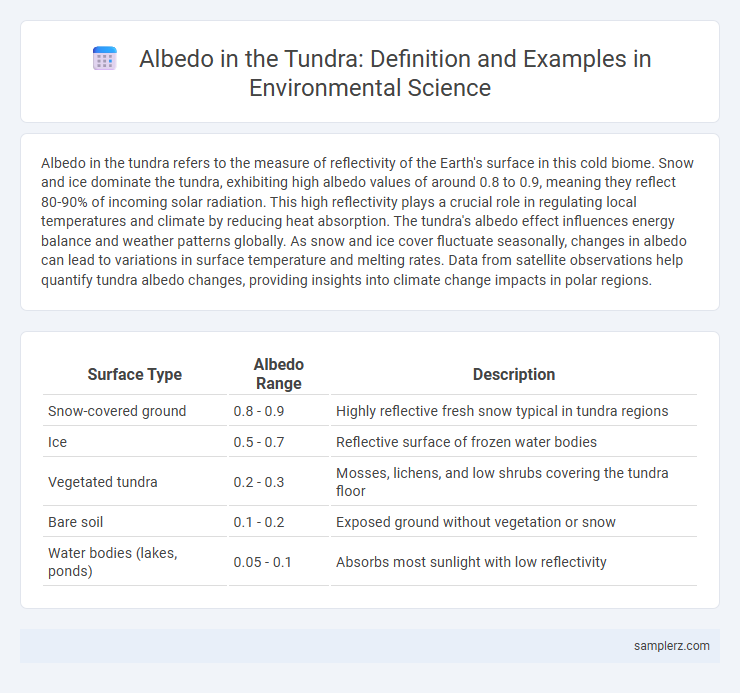Albedo in the tundra refers to the measure of reflectivity of the Earth's surface in this cold biome. Snow and ice dominate the tundra, exhibiting high albedo values of around 0.8 to 0.9, meaning they reflect 80-90% of incoming solar radiation. This high reflectivity plays a crucial role in regulating local temperatures and climate by reducing heat absorption. The tundra's albedo effect influences energy balance and weather patterns globally. As snow and ice cover fluctuate seasonally, changes in albedo can lead to variations in surface temperature and melting rates. Data from satellite observations help quantify tundra albedo changes, providing insights into climate change impacts in polar regions.
Table of Comparison
| Surface Type | Albedo Range | Description |
|---|---|---|
| Snow-covered ground | 0.8 - 0.9 | Highly reflective fresh snow typical in tundra regions |
| Ice | 0.5 - 0.7 | Reflective surface of frozen water bodies |
| Vegetated tundra | 0.2 - 0.3 | Mosses, lichens, and low shrubs covering the tundra floor |
| Bare soil | 0.1 - 0.2 | Exposed ground without vegetation or snow |
| Water bodies (lakes, ponds) | 0.05 - 0.1 | Absorbs most sunlight with low reflectivity |
Understanding Albedo: A Key Process in the Tundra
Albedo in the tundra region typically ranges from 0.4 to 0.8, reflecting a significant portion of solar radiation due to snow-covered surfaces and sparse vegetation. This high reflectivity plays a crucial role in regulating local temperatures and influencing climate patterns by limiting heat absorption during the brief summer months. Understanding albedo variations helps scientists predict the tundra's response to changing snow cover and increasing temperatures associated with climate change.
Snow Cover and its High Albedo Effect in Tundra Ecosystems
Snow cover in tundra ecosystems exhibits an exceptionally high albedo, reflecting up to 80-90% of incoming solar radiation. This high reflectivity plays a critical role in regulating local climate by reducing surface temperatures and limiting heat absorption. The persistent snow cover helps maintain permafrost stability and influences energy balance, affecting both vegetation patterns and overall ecosystem dynamics.
Impact of Vegetation on Albedo Variations in Tundra
Vegetation significantly influences albedo variations in tundra ecosystems, with mosses and lichens typically exhibiting higher albedo values compared to darker shrubs and grasses. Seasonal changes in plant cover and growth stages alter surface reflectivity, impacting local energy balance and temperature regulation. Understanding these variations is crucial for modeling climate feedback mechanisms in Arctic regions.
Seasonal Changes and Their Influence on Tundra Albedo
Seasonal changes in the tundra significantly affect albedo levels due to varying snow and vegetation cover. In winter, the extensive snow cover in the tundra increases albedo, reflecting up to 80-90% of solar radiation, while during summer, exposed dark soil and vegetation reduce albedo to approximately 10-30%. These fluctuations in albedo influence local and global climate processes by altering the energy balance and feedback mechanisms in polar regions.
The Role of Ice and Permafrost in Reflectivity Levels
In the tundra, high albedo levels result from extensive ice and permafrost coverage, which reflect a significant portion of solar radiation back into the atmosphere. Seasonal melting reduces surface reflectivity, exposing darker soil and vegetation that absorb more heat, contributing to localized warming effects. Persistent permafrost maintains long-term high albedo, playing a critical role in regulating regional climate by limiting solar energy absorption.
Albedo Feedback Mechanisms and Climate Regulation in the Tundra
The tundra's high albedo, primarily due to its extensive snow and ice cover, reflects a significant portion of solar radiation, helping regulate regional climate by maintaining cooler surface temperatures. Albedo feedback mechanisms in the tundra amplify climate change effects; as warming melts snow and ice, darker exposed ground absorbs more heat, accelerating warming and further reducing albedo. This positive feedback loop plays a critical role in tundra climate dynamics and contributes to global climate regulation through its impact on energy balance.
Dark Surfaces: Mosses, Lichens, and Reduced Albedo
Dark surfaces such as mosses and lichens in the tundra contribute to reduced albedo by absorbing more solar radiation compared to the surrounding snow and ice. This absorption accelerates localized warming and contributes to the thawing of permafrost. Changes in vegetation cover and surface darkening play a critical role in altering energy balance and climate feedback mechanisms in polar ecosystems.
Human Activities Altering Albedo in Tundra Regions
Human activities in tundra regions, such as infrastructure development and resource extraction, significantly alter surface albedo by introducing dark materials and disrupting the natural snow cover. The reduction of snow and ice increases solar absorption, accelerating permafrost thaw and contributing to local warming. Increased soot deposition from industrial pollution further darkens the tundra surface, amplifying the albedo change and its climatic impacts.
Satellite Observations of Albedo Patterns in the Arctic Tundra
Satellite observations reveal that the Arctic tundra exhibits high albedo values, especially during the snow-covered winter months, reflecting up to 80% of incoming solar radiation. Seasonal variations detected via remote sensing show a significant albedo decrease during summer thaw, when exposed soil and vegetation absorb more sunlight. These data are critical for modeling the tundra's energy balance and predicting climate feedback mechanisms in polar regions.
Implications of Albedo Shifts for Tundra Biodiversity and Climate
Albedo shifts in the tundra, caused by changes in snow cover and vegetation, significantly influence local climate regulation and biodiversity patterns. A decrease in albedo due to darker, exposed soil and plant life accelerates warming, disrupting permafrost stability and altering habitats for native species such as Arctic fox and caribou. These changes threaten ecological balance, leading to shifts in species distribution and increased vulnerability of tundra ecosystems to climate change impacts.

example of albedo in tundra Infographic
 samplerz.com
samplerz.com